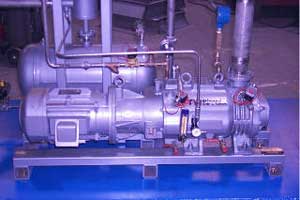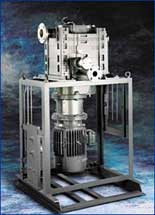Dry Vacuum Pumps
Dry Vacuum Pumps are the newest development in the vacuum pump industry. They offer a number of advantages over the traditional vacuum pump designs. There is “No Oil, No Water” in contact with the process vapors which makes them environmentally friendly. There are two markets of dry pumps: Industrial and Chemical.
NOTE: there is a very common misconception that “No Oil, No Water” also means “No Maintenance, No Problems”. ALL vacuum pumps have advantages and disadvantages, including Dry Vacuum Pumps. Reviewing your application with a company, like Wintek, who are experts in vacuum applications, but who are not trying to “sell” you on a particular manufacturer’s design, can save you from using the wrong vacuum pump for the application.
Industrial Dry Vacuum Pumps
Industrial dry vacuum pumps include: regenerative blowers, rotary lobe blowers, dry rotary vane vacuum pumps, and more recently dry single stage “claw” designs, and even newer screw designs. Most of these designs are limited in vacuum to about 15-24”HgV. If your process is dry air, free of solids, then these may be worth considering. If the process gases contain moisture, droplets or solids, taking caution is necessary.
 Chemical Duty Dry Vacuum Pumps
Chemical Duty Dry Vacuum Pumps
Solvents can be condensed and recovered on the discharge side of the vacuum pump. This makes this design a good choice for solvent recovery. All the chemical duty dry pumps can pull vacuum levels to 5 to .05 Torr depending upon the design. These advantages come at a relatively high cost, compared to other technologies. There are three major types of chemical duty dry vacuum pumps: screw, multi-lobe, and Claw.
Dry Claw Vacuum Pump
All the manufacturers say that their dry pumps can handle corrosive vapors, and this is true to some extent. Dry vacuum pumps are “dry”, so there is no natural internal flushing of the process out of the vacuum pump. Corrosives are “handled” by keeping them as vapors, and not allowing them to condense. You must use special caution when handling corrosives, using start-up and shut-down purge cycles, and while protecting the pump from process upsets. Coatings on the screw type dry vacuum pumps is advertised as offering corrosion protection. However, for some manufacturers, this offers limited protection because the coating is in reality a wear coating for manufacturing and not “pin-hole free”. For the cooler operating dry pumps (350°F and less), with a PFA or other Teflon type coating, you can have more confidence that the coating is not actually a wear coating, and the coating will hold up better.
Some Dry pumps can also run HOT, some even in excess of 500°F. So potential auto-ignition concerns of some solvents can be a huge potential safety liability. Also, since they run hot, polymerization of process vapors can build up on the close running components. This creates maintenance problems, or removal of the wear coating. Even cool running dry pumps can have polymerization, because most of these dry pumps only cool the claws or screws with an air bleed into the process, so the rotating claws and screws become the hottest part of the pump.
 Chemical Duty Dry Vacuum Pumps
Chemical Duty Dry Vacuum Pumps

